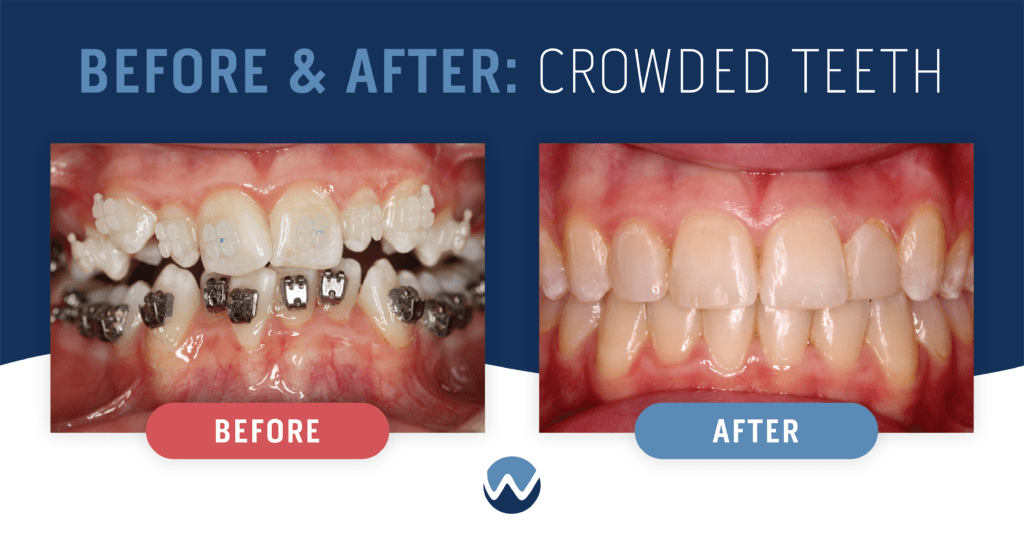Crowded bottom teeth, also known as mandibular crowding, is a common orthodontic issue that affects many individuals. Misaligned or overcrowded teeth can affect aesthetics, oral health, and even overall well-being. This comprehensive guide will explore various approaches to fixing crowded bottom teeth, providing insights into treatments, latest techniques, and potential challenges.

Image: theteethblog.com
Understanding Crowded Bottom Teeth
Crowded bottom teeth occur when there is insufficient space in the dental arch to accommodate all the teeth, causing them to overlap and overlap. This can result from several factors, including genetic predisposition, premature tooth loss, prolonged thumb sucking, or dental abnormalities. Crowded teeth can lead to a malocclusion or “bad bite,” impacting chewing, speech, and the overall health of the teeth and gums.
Types of Treatment Options
Fixing crowded bottom teeth involves a treatment plan customized to the individual’s specific needs, considering factors such as age, severity of crowding, and desired outcomes.
1. Orthodontics (Braces or Aligners)
Orthodontic treatment is a common and effective approach to correct crowded teeth. Braces or aligners are orthodontic appliances designed to gradually move teeth into the desired alignment. Braces consist of metal brackets bonded to the teeth and connected by wires, while aligners are clear, removable trays that must be worn for a specified number of hours each day.

Image: www.woodhilldentalspecialties.com
Traditional Metal Braces
Traditional braces have been used for decades to correct dental misalignments. They provide precise control over tooth movement, allowing the orthodontist to achieve the desired results accurately. While traditional metal braces are highly effective, they are also the most visible type of orthodontic treatment.
Clear Ceramic Braces
Clear ceramic braces offer a less noticeable alternative to metal braces. Made from tooth-colored material, they blend in with the teeth, making them a more discreet option. However, they may not be as durable as metal braces.
Lingual Braces
Lingual braces are placed on the back of the teeth, making them completely invisible from the front. This is the most aesthetic orthodontic option, but it can be more expensive and may require a longer treatment time.
Clear Aligners
Clear aligners are a removable orthodontic appliance that has gained popularity in recent years. They are made of a clear, plastic material that fits snugly over the teeth. A series of aligners is worn over time, each one gradually shifting the teeth towards the desired alignment. Clear aligners are nearly invisible, making them a popular choice for adults and teenagers.
2. Tooth Extraction
In some cases, tooth extraction may be necessary to create space for the crowded teeth to move. This is usually considered when there is severe crowding or the teeth are excessively large. However, tooth extraction should be considered carefully, as it can have long-term implications for dental health.
3. Expanders
Expanders are orthodontic devices that are used to widen the dental arch and create space for crowded teeth. They are often used in conjunction with braces or aligners to provide additional room for teeth to move. There are different types of expanders, including palatal expanders for the upper jaw and quad-helix expanders for the lower jaw.
4. Surgery
In rare and severe cases, surgery may be recommended to correct crowded bottom teeth. This is typically performed in conjunction with orthodontic treatment to achieve optimal results. Surgical procedures may involve removing impacted teeth, reshaping the jawbone, or performing gum or bone grafting.
Choosing the Right Treatment
The best treatment option for fixing crowded bottom teeth will vary depending on the individual’s specific needs and preferences. It is important to have an in-depth consultation with an experienced orthodontist who can assess the condition of the teeth and jaw, discuss treatment options, and recommend the most appropriate approach. Factors to consider include the severity of crowding, the patient’s age, overall oral health, lifestyle, and personal preferences.
Timeline and Expectations
The length of orthodontic treatment for crowded bottom teeth varies widely. It typically takes anywhere from six months to three years, depending on the complexity of the case and the chosen treatment option. During treatment, regular visits to the orthodontist are necessary for adjustments and monitoring progress. Patients should be prepared to commit to the treatment plan and maintain good oral hygiene practices to achieve the best results.
Cost and Insurance Coverage
The cost of orthodontic treatment for crowded bottom teeth can vary depending on the location, the orthodontist’s fees, and the complexity of the case. The cost of traditional metal braces can range from $3,000 to $7,000, while clear aligners can range from $4,000 to $8,000. Dental insurance may cover a portion of the treatment costs, so it is advisable to check with the insurance provider to determine the level of coverage.
After Treatment
Once orthodontic treatment is completed, it is crucial to wear a retainer to maintain the corrected teeth position. The retainer should be worn as directed by the orthodontist, usually at night or for a few hours each day. Failure to wear the retainer correctly can lead to the teeth shifting back to their original crowded position.
How To Fix Crowded Bottom Teeth
Conclusion
Fixing crowded bottom teeth is an investment in oral health and aesthetics. With a wide range of treatment options available, it is possible to achieve a straighter smile and improve dental health. Consulting with an experienced orthodontist is the first step towards a successful treatment journey. By committing to the recommended treatment plan, following oral hygiene instructions, and wearing a retainer as prescribed, individuals can enjoy lasting results, a healthier smile, and increased confidence.